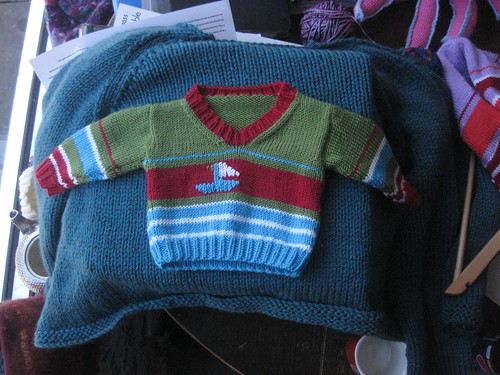In fact, the internet has a lot to answer for in terms of gauge. Without the internet I would have never known about continental knitting (the one where you work with your left hand rather than right like I talked about in this blog post). Using a different method of knitting changes your tension like nobody's business - often using continental as opposed to English style gives a knitter a looser tension (I've heard a few of you complain that you can't reach gauge on American patterns without significantly increasing needle size which I suspect is because most English knitters tend to knit English style - but I haven't done any scientific testing on that...). Anyway, here's a photo to show you the difference that it can make:
Not a great photo but you can definitely see the difference between the first section of rib and the second. In the first I had been knitting English style completely, dropping each colour as I was working the other. In the second section I'd been using two-handed fairisle with the grey yarn in my left hand and the purple in my right. This is the second in a pair of mittens for my bestest friend (for Christmas last year...) and I'm in two minds whether to rip and redo, the first mitts have perfect tension in the ribbed section and this is obviously bit of a mess, but it would be the fourth time I've ripped the bloody thing and really, when we're in May and I have three other Chistmas presents still to knit... Well, you get the idea. Anyway, there's a good example of changed tensions.
So - where were we?
Right, so imagine you've chosen your substituted yarn (or indeed the yarn that the pattern calls for) and you've got it home and you know that the yarn that you have and the yarn that the pattern calls for is an aran weight and you've got the right needles and the designer is English and you're English and you're not stressed so you've got every right to cast on straight away - right? Wrong! Sorry. Now we're talking tension squares...
Like I said before, tension squares are all about seeing whether you and the designer are on the same page. When you're writing a pattern, the cast on amounts don't just come out of the air - the designer finds the measurement that the stitches need to cover (plus or minus the amount of ease they've specified) and multiplies that amount by the gauge that they're using. So:
The gauge is 5.5 stitches per inch (roughly DK, let's not worry abut rows for now).
We're knitting a jumper, in pieces as opposed to in the round, for a woman with a fourty inch chest. The designer has chosen a comfortable two inches of positive ease and (they aren't an idiot so) they realise that most women's bums (in the UK at least) are bigger than their busts so the welt, which falls around the hip somewhere, needs to measure 46 inches.
We divide 46 inches by two (we're knitting this in pieces remember) = 23 inches.
So we multiply 23 by 5.5 which the calculator tells me is 126.5 stitches. Obviously we can knit half a stitch but we do also need a bit of allowance for sewing together so the designer tells us to cast on 128 stitches.
Perfect! If you're getting gauge that is. Now, say we're knitting tight and get a gauge of 6.5 stitches to the inch, how does that work out?
128 divided by 6.5 = something like 19.5 inches.
19.5 times 2 = 39.
So, if we knit this, with a gauge of 6.5 we're going to get a jumper that measures 39 inches around as opposed to 46. Mega difference ey?
Of course, you can use this to your advantage - if you want a jumper that measure 39 inches around and you get gauge at 6.5 then brilliant! I often tell people that come into the shop that if they want to use a different yarn weight they can often just use a different size instruction (keeping an eye on row gauge and length etc). In fact, I used this exact technique on this baby jumper:

I did it by accident of course, forgot to change to needle size from a 3.75mm to a 4mm (silly knitter...), but it reduced the chest size by a good couple of inches which means that rather than fitting a 0-3 month like the pattern suggests it would fit a very much grown preemie - without me having to think about it at all! I'm calling this a win!
Okay, this was only meant to be a two post series but I reckon that's enough brain addling for today, so pop back tomorrow and we'll talk some more!
Love,
Eleanor. :)


No comments:
Post a Comment